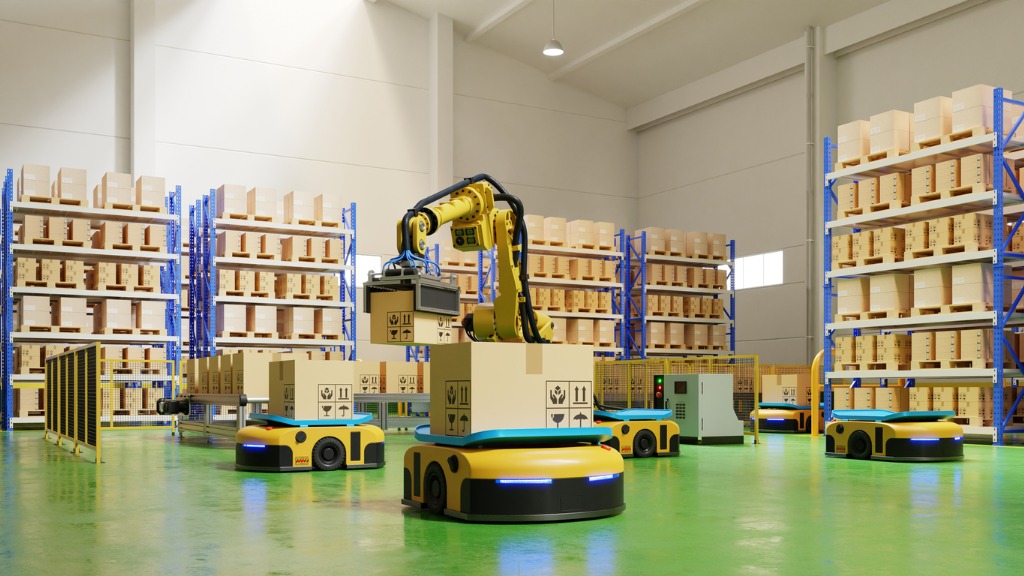Warehouse managers are always looking for new ways to work faster and smarter since speed and efficiency are critical. As the demand for quick and accurate order fulfillment has increased with the incredible popularity of e-commerce, driving up labor costs, warehouse robotics has provided businesses with a revolutionary way to conduct business.
In recent years, warehouse robotics has risen to prominence in supply chains, distribution and fulfillment centers, and warehouse management circles. It continues to play an essential role in warehouse automation.
This article will take a closer look at the different types of robots designed to streamline warehouse operations. Keep reading for more information and discover how BILT Industries can help move your company into the future through our robotics-compatible shelving.
What Are Warehouse Robots?
Warehouse robotics is a broad phrase that refers to the various automated devices and systems that can improve speed, efficiency, and accuracy in a warehouse. Warehouse robotics is “the use of automated systems, robots, and specialized software to transport materials, perform various activities, and streamline/automate warehouse processes.”
Essentially, warehouse robots are specialized automated robots that utilize artificial intelligence to perform specific activities in warehouses. As a result, they can play a significant part in warehouse automation, resulting in substantial benefits for your company. Let’s take a closer look at the ways warehouse robotics can improve logistics operations.
- Picking
- Sorting
- Packaging
- Transporting
- Replenishing
Picking
Picking is the process of locating and retrieving the correct stock to complete an order, and it is one of the most common applications of warehouse robots. Robots are widely used in warehouses to assist workers, generally guiding the next picking position.
Sorting
When done manually, sorting can be an incredibly time-consuming task. Warehouse robots with cameras and sensors can now complete tasks considerably more rapidly and efficiently than humans, with a significantly narrower margin of error.
Packaging
Another labor-intensive warehouse operation that can benefit from automation is packaging. Some robots include automated technologies that help speed up packaging tasks and use information, such as a product’s overall weight and dimensions, to determine the best carton size for a particular order and guide associates to the appropriate task.
Transporting
Transporting inventory throughout a warehouse is one of the most time-consuming and labor-intensive chores for workers, but warehouse robots can make the operation much more efficient. Whether individual objects need to be grabbed and moved, or entire pallets or big bins need to be carried, robots can assist.
Replenishing
Lastly, warehouse robotics can also help with stock replenishment duties by keeping stock levels up to date and taking care of the labor-intensive aspects of the job. Warehouse robots can ensure that there are no items out of stock and keep backorders to a minimum by automating the restocking of goods.
6 Types of Warehouse Robots
The warehouse robotics sector encompasses a wide range of robots that perform several tasks and operations. Here’s a breakdown of the various types of warehouse robots.
- Automated Guided Vehicles (AGVs)
- Automated Storage and Retrieval Systems (AS/RSs)
- Collaborative Robots
- Robotic Arms
- Goods-to-Person (G2P)
- Autonomous Mobile Robots (AMRs)
Automated Guided Vehicles (AGVs)
Within warehouse facilities, automated guided vehicles (AGVs) assist in transporting commodities, supplies, and inventory. AGVs are utilized in operations to replace manually operated forklifts and pick carts. Some AGVs navigate warehouses independently, following pre-determined paths indicated by cables, magnetic strips, tracks, sensors, and other physical guides. In contrast, other AGVs navigate workspaces, identify obstacles, and prevent collisions using cameras, lidar, infrared, and other advanced technology.
Automated Storage and Retrieval Systems (AS/RSs)
Automated storage and retrieval systems (AS/RSs) are computer-controlled robots that aid in inventory management and on-demand item storage and retrieval. These systems are frequently linked with warehouse execution software and designed to help with quick product retrieval and placement. They can readily traverse product aisles and vertical heights to deposit or take products like cranes or shuttles on fixed tracks or speed up fulfillment operations and material-handling activities.
Collaborative Robots
Collaborative robots, also known as “cobots,” are semi-autonomous mobile robots that assist human workers with various activities. Some cobots accompany human pickers throughout the warehouse floor and serve as portable storage bins for orders, while others lead associates and transfer loads through the warehouse, directing workflows.
Robotic Arms
Multi-jointed limbs manipulate products in distribution centers and warehouses via articulated robotic arms, a pick-and-place robot. These arms can be utilized in various warehouse tasks since they can move, turn, lift, and maneuver items. Managers often use them for receiving duties, including moving goods from pallets to racks and picking, packing, and shipping.
Goods-to-Person (G2P)
Goods-to-person (G2P) technology works in the same way as an AS/RS system. G2P technology uses an automated storage system to send items to pick stations where humans fill requests. While G2P systems can provide the highest returns on investment, they can necessitate considerable infrastructure improvements, resulting in significant capital expenditures and installation downtime.
Autonomous Mobile Robots (AMRs)
In the same way that AGVs transfer inventory and materials throughout a warehouse, autonomous mobile robots (AMRs) do the same. Unlike AGVs, which travel along set paths, AMRs navigate independently without the assistance of physical guides or markers, thanks to onboard sensors and processors that assess the environment and determine optimal routes. An AMR can learn about its surroundings, understand its location, and plan its course from one waypoint to the next.
5 Benefits of Warehouse Robotics
Businesses use warehouse robotics of all types to improve order fulfillment, inventory management, and daily operations. The utilization of advanced warehouse robotics can afford you the following benefits.
- Improved accuracy
- Increased efficiency
- Reduced risk
- Automated tasks
- Reduced workforce costs
Improved Accuracy
Investing in warehouse robotics improves inventory management productivity and accuracy. Human errors can be costly to organizations and contribute to decreased consumer satisfaction. Warehouse robots ensure high levels of accuracy in order fulfillment and warehousing operations by automating the handling, picking, sorting, and resupplying of products.
Increased Efficiency
The picking process is one of the most time-consuming aspects of working in a warehouse. According to estimates, some warehouse workers spend half of their day roaming around the warehouse looking for products. With advanced artificial intelligence, warehouse managers can automate these jobs, allowing the staff to focus on higher-value duties or skilled work that is more rewarding for them and the organization.
Reduced Risk
With robotics, a warehouse operation’s unpleasant and risky components no longer require human workers to complete. Warehouse robots relieve physical and mental strain on human workers by taking on some dangerous and undesirable activities. Human workers can now work on more value-added duties and reduce injury risk by having warehouse robots handle the backbreaking, monotonous tasks.
Automated Tasks
By employing robotics, warehouses can improve operational efficiency, reduce mistakes, and conduct order fulfillment procedures with greater accuracy. Human workers can devote their time and energy to more complex jobs requiring fine motor skills or critical thinking by using warehouse robots to automate laborious, manual operations.
Reduced Workforce Costs
The warehouse business has a well-documented labor shortage, making it challenging to attract and retain qualified employees. By using robotics, companies can potentially save a lot of money on labor expenditures, allowing them to invest in the competent employees they already have.
AMR-Compatible Shelving from BILT Industries
Warehouse automation has advanced dramatically in recent years, particularly in the area of warehouse robotics. As more companies introduce warehouse robots into their logistics operations, understanding how the new technology can benefit your business is crucial to remaining competitive.
Of course, robots are not flawless, and you need compatible shelving for robots like AMRs and AGVs to work effectively. At BILT Industries, we offer AMR-compatible storage solutions because we recognize this technology’s positive effects on the industry.
If you are not quite ready to invest in advanced robot solutions, we also offer more traditional shelving solutions that are easy to assemble and customize but don’t sacrifice functionality and sturdiness. Check out our signature shelving lines, including the Klip-BILT II®, Speedi-BILT®, and Quick-BILT®. If you are interested in learning more about our storage solutions and services, give us a call at (913) 675-2052 today!

